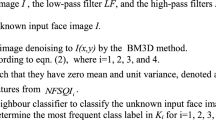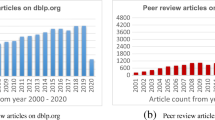Abstract
Varied Illumination and unequal contrast are the critical challenges in the face recognition system. This paper presents a multi-stage hybrid model to handle extreme illumination, unequal contract, and varied pose challenges. These challenges are handled within pre-processing and feature generation stages. In the pre-processing stage, the content and structural feature-based feature exposing and region selection method is defined. In the second stage, the hybrid feature generation- adaptive weber and speeded up robust features(AWSURF) model is applied on rectified and normalized face images. In this stage, a weber filter is applied for generating the exposing the structural contents. The Speeded up Robust Features (SURF) method is applied to the weber face for extracting the illumination and pose robust features. The proposed model has experimented on Yale, Extended-Yale and CMU-PIE datasets. The proposed model is experimented and validated against EigneFace, Local Binary Pattern(LBP), Gabor,EigenFace+Gabor, Gabor+LBP,Weber, SURF,Weber+SURF feature processors. The experimental analysis is done against accuracy and error measures. The proposed model achieved the 92.88%, 91.77% and 99.09% accuracy against Yale, Extended-Yale and CMU-PIE datasets and outperformed the experimented handcraft approaches. The analysis results confirm that the proposed model achieved a higher average accuracy rate against state-of-art deep learning and handcraft approaches.























Similar content being viewed by others
Data availability
The datasets described in the paper are cited properly.
References
Alotaibi S, Alharbi N, Kurdi H (2017) Face recognition under varying illumination based on homomorphic filter and local binary patterns. Intelligent systems conference (IntelliSys):585-591
Alrjebi MM, Liu W, Li L (2018) Face recognition against illuminations using two directional multi-level threshold-LBP and DCT. Multimed Tools Appl 77:25659–25679
Bay H, Ess A, Tuytelaars T, Gool LV (2008) Speeded-up robust features (SURF). Comput Vis Image Underst 110(3):346–359
Chanda SM (2000) A multi-scale morphological approach to local contrast enhancement. Signal Process 80(4):685–696
Chen J, Shan S, He C, Zhao G, Pietikäinen M, Chen X, Gao W (2010) WLD: A Robust Local Image Descriptor. IEEE Trans Pattern Anal Mach Intell 32(9):1705–1720
Chen X, Lan X, Liang G, Liu J, Zheng N (2017) Pose-and-illumination-invariant face representation via a triplet-loss trained deep reconstruction model. Multimed Tools Appl 76:22043–22058
Chen GY, Bui TD, Krzyzak A (2019) Illumination invariant face recognition using dual-tree complex wavelet transform in logarithm domain. J Electr Eng 70(2):113–121
Cherifi CF, Deriche M, Hidouci K-W (2019) An improved revocable fuzzy vault scheme for face recognition under unconstrained illumination conditions. Arab J Sci Eng 44:7203–7217
Dalal S, Vishwakarma VP (2020) A novel approach of face recognition using optimized adaptive illumination–normalization and KELM. Arab J Sci Eng 45:9977–9996
Dandpat SK, Meher S, Bopche V (2018) Uneven illumination compensation for unconstrained face recognition using LBP. 3rd international conference for convergence in technology (I2CT):1-6
Faraji MR, Qi X (2018) Face recognition under varying illuminations with multi-scale gradient maximum response. Neurocomputing 308:87–100
Gangonda SS, Patavardhan PP, Karande KJ (2018). An extensive survey of prominent researches in face recognition under different conditions. Fourth international conference on computing communication control and automation (ICCUBEA):1-6
Gao S, Zhang Y, Jia K, Lu J, Zhang Y (2015) Single sample face recognition via learning deep supervised autoencoders. IEEE Trans Inf Forensics Secur 10(10):2108–2118
Hassaballah M, Aly S (2015) Face recognition: challenges, achievements and future directions. IET Comput Vis 9(4):614–626. https://doi.org/10.1049/iet-cvi.2014.0084
Hu C, Lu X, Ye M, Zeng W (2017) Singular value decomposition and local near neighbors for face recognition under varying illumination. Pattern Recogn 64:60–83
Hu C-H, Lu X-B, Wu F, Wu S-S, Jing X-Y (2019) General logarithm difference model for severe illumination variation face recognition. Multimed Tools Appl 78:27425–27447
Hu C-H, Lu X-B, Liu P, Jing X-Y, Yue D (2019) Single sample face recognition under varying illumination via QRCP decomposition. IEEE Trans Image Process 28(5):2624–2638
Jiménez-Sánchez AR, Mendiola-Santibañez JD (2009) Morphological background detection and enhancement of images with poor lighting. IEEE Trans Image Process 18(3):613–623
Juneja K (2015) MFAST processing model for occlusion and illumination invariant facial recognition. Advanced computing and communication technologies: proceedings of the 9th ICACCT: 161-170
Juneja K (2015) A dynamic segment based statistical derived PNN model for noise robust speech recognition. Third international conference on image information processing (ICIIP):320-325
Juneja K (2017) Ring segmented and block analysis based multi-feature evaluation model for contrast balancing. International Conference on Information, Communication and Computing Technology: 181–193
Juneja K (2017) A noise robust VDD composed PCA-LDA model for face recognition. International Conference on Information, Communication and Computing Technology: 216–229
Juneja K (2020) MPMFFT based DCA-DBT integrated probabilistic model for face expression classification. J King Saud Univ - Comput Inf Sci 32(5):618–633
Juneja K, Gill NS (2015) Tied multi-rubber band model for camera distance, shape and head movement robust facial recognition. International conference on applied and theoretical computing and communication technology (iCATccT):218-233
Juneja K, Rana C (2018) Multi featured fuzzy based block weight assignment and block frequency map model for transformation invariant facial recognition. Int J Image Graph Signal Process 10(3):1–8
Juneja K, Rana C (2019) A feature fusion method for effective face recognition under variant illumination and Noisy conditions. In: Applications of Computing, Automation and Wireless Systems in Electrical Engineering, pp 945–957
Juneja K, Rana C (2021) An extensive study on traditional-to-recent transformation on face recognition system. Wirel Pers Commun 118:3075–3128. https://doi.org/10.1007/s11277-021-08170-3
Kasperek J (2004) Real time morphological image contrast enhancement in virtex FPGA. Lecture Notes in Computer Science:430–440
Kathuria D, Yadav J (2018) An improved illumination invariant face recognition based on Gabor wavelet transform. Conference on information and communication technology (CICT):1–6.
Lai Z-R, Dai D-Q, Ren C-X, Huang K-K (2015) Multi-scale logarithm difference Edgemaps for face recognition against varying lighting conditions. IEEE Trans Image Process 24(6):1735–1747
Lee S (2007) An efficient content-based image enhancement in the compressed domain using retinex theory. IEEE Trans Circuits SystideoTechnol 17(2):199–213
Leng L, Zhang J, Xu J, Khan MK, Alghathbar K (2010) Dynamic weighted discrimination power analysis: a novel approach for face and palmprint recognition in DCT domain. Int J Phys Sci 5(17):467–471
Leng L, Zhang J, Chen G, Khan MK, Alghathbar K (2011) Two-directional two-dimensional random projection and its variations for face and palmprint recognition. International conference on computational science and its application:458
Leng L, Zhang S, Bi X, Khan MK (2012) Two-dimensional cancelable biometric scheme. International Conference on Wavelet Analysis and Pattern Recognition:164–169
Leng L, Li M, Kim C, Bi X (2017) Dual-source discrimination power analysis for multi-instance contactless palmprint recognition. Multimed Tools Appl 76:333–354
Li L, Ge H, Gao J (2016) Maximum-minimum-median average MSD-based approach for face recognition. AEU - Int J Electron C 70(7):920–927. https://doi.org/10.1016/j.aeue.2016.04.007
Li L, Ge H, Tong Y, Zhang Y (2018) Face recognition using Gabor-based feature extraction and feature space transformation fusion method for single image per person problem. Neural Process Lett 47:1197–1217
Li Y, Hu H, Zhou G (2019) Using data augmentation in continuous authentication on smartphones. IEEE Internet Things J 6(1):628–640
Li C, Huang Y, Xue Y (2019) Dependence structure of Gabor wavelets based on copula for face recognition. Expert Syst Appl 137:453–470
Li Y, Hu H, Zhu Z, Zhou G (2020) SCANet: sensor-based continuous authentication with two-stream convolutional neural networks. ACM Trans Sens Netw 16(3):27
Li Y, Zou B, Deng S, Zhou G (2020) Using feature fusion strategies in continuous authentication on smartphones. IEEE Internet Comput 24(2):49–56
Liang J, Hou Z, Chen C, Xu X (2016) Supervised bilateral two-dimensional locality preserving projection algorithm based on Gabor wavelet. SIViP 10:1441–1448
Lu T, Guan Y, Zhang Y, Qu S, Xiong Z (2018) Robust and efficient face recognition via low-rank supported extreme learning machine. Multimed Tools Appl 77:11219–11240
Machidon AL, Machidon OM, Ogrutan PL (2019) Face Recognition Using Eigenfaces, Geometrical PCA Approximation and Neural Networks. 42nd International Conference on Telecommunications and Signal Processing (TSP):80–83
Meena HK, Sharma KK, Joshi SD (2017) Face recognition under variations in illumination using the phase of fractional Fourier transform. International conference on emerging trends in computing and communication technologies (ICETCCT):1-4
Mustapha A, Oulefki A, Bengherabi M, Boutellaa E, Algaet MA (2017) Towards non-uniform illumination face enhancement via adaptive contrast stretching. Multimed Tools Appl 76:21961–21999
Oloyede MO, Hancke GP, Myburgh HC (2020) A review on face recognition systems: recent approaches and challenges. Multimed Tools Appl. 79:27891–27922. https://doi.org/10.1007/s11042-020-09261-2
Park S, Yu S, Kim M, Park K, Paik J (2018) Dual autoencoder network for Retinex-based low-light image enhancement. IEEE Access 6:22084–22093
Parkhi OM, Vedaldi A, Zisserman A (2015). Deep Face Recognition. Proceedings of the British Machine Vision Conference:1–12
Peli E (1990) Contrast in complex images. J Opt Soc Am A 7(10):2032–2040
Qahwaji R, Al-Fahdawi S, Al-Waisy AS (2020) A multi-biometric face recognition system based on multimodal deep learning representations. In M. Hassaballah, A. I. Awad, deep learning in computer vision:38
Salembier P, Serra J (1995) Flat zones filtering, connected operators and filters by reconstruction. IEEE Trans Image Process 3(8):1153–1160
Sellahewa H, Jassim SA (2010) Image-quality-based adaptive face recognition. IEEE Trans Instrum Meas 59(4):805–813
Serajeh R, Mohammadzadeh Z, Ghavitandarjazi H (2017) Face recognition in uncontrolled conditions. 4th International Conference on Knowledge-Based Engineering and Innovation (KBEI):0902–0906
Silwal R, Alsadoon A, Prasad PW, Alsadoon OH, Al-Qaraghuli A (2020) A novel deep learning system for facial feature extraction by fusing CNN and MB-LBP and using enhanced loss function. Multimed Tools Appl 79:31027–31047
Susstrunk S, Winkler S (2004) Color image quality on the internet. Proc. IS&T/SPIE Electronic Imaging: Internet Imaging V, 5304:118–131
Tang Y, Salakhutdinov R, Hinton GE (2012) Deep Lambertian networks. Proceedings of the 29 th International Conference on Machine Learning:1623–1630
Terol-Villalobos R (2001) Morphological image enhancement and segmentation. Adv Imaging Electron Phys 118:207–273
Terol-Villalobos I (2004) Morphological connected contrast mappings based on top-hat criteria: a multi-scale contrast approach. Opt Eng 43(7):1577–1595
Vishwakarma VP, Goel T (2019) An efficient hybrid DWT-fuzzy filter in DCT domain based illumination normalization for face recognition. Multimed Tools Appl 78:15213–15233
Vishwakarma VP, Dalal S, Sisaudia V (2018) Efficient feature extraction using DWT-DCT for robust face recognition under varying illuminations. 2nd IEEE international conference on power electronics, intelligent control and energy systems (ICPEICES):982-987
Wang Y, Wu Y (2010) Face recognition using Intrinsicfaces. Pattern Recogn 43(10):3580–3590
Wang J-W, Le NT, Lee J-S, Wang C-C (2018) Llumination compensation for face recognition using adaptive singular value decomposition in the wavelet domain. Inf Sci 435:69–93
Yadav J, Rajpal N, Mehta R (2019) An improved illumination normalization and robust feature extraction technique for face recognition under varying illuminations. Arab J Sci Eng 44(11):9067–9086
Yang C, Wu S, Fang H, Er MJ (2019) Adaptive weber-face for robust illumination face recognition. Computing 101:605–619
Yu J, Liu H, Zheng X (2020) Two-dimensional joint local and nonlocal discriminant analysis-based 2D image feature extraction for deep learning. Neural Comput & Applic 32:6009–6024
Zhang Y, Hu C, Lu X (2018) Face recognition under varying illumination based on singular value decomposition and retina modeling. Multimed Tools Appl 77:28355–28374
Zhang Y, Lu X, Li J (2019) Single-sample face recognition under varying lighting conditions based on logarithmic total variation. SIViP 13:657–665
Zhao Z, Liang J (2018) NSCT-based adaptive illumination processing for face recognition. International conference on information systems and computer aided education (ICISCAE):218-221
Zhi R, Ruan Q (2008) Two-dimensional direct and weighted linear discriminant analysis for face recognition. Neurocomputing 71:16–18
Funding
No funds received for this research.
Author information
Authors and Affiliations
Corresponding author
Ethics declarations
Conflict of interest
There is no conflict of interest, financial or others. As the sole author, I ensured the ethical approval and participation of the research.
Additional information
Publisher’s note
Springer Nature remains neutral with regard to jurisdictional claims in published maps and institutional affiliations.
Rights and permissions
Springer Nature or its licensor holds exclusive rights to this article under a publishing agreement with the author(s) or other rightsholder(s); author self-archiving of the accepted manuscript version of this article is solely governed by the terms of such publishing agreement and applicable law.
About this article
Cite this article
Juneja, K. Design of a multi-stage hybrid model for face recognition in varied illumination conditions. Multimed Tools Appl 82, 5627–5662 (2023). https://doi.org/10.1007/s11042-022-13586-5
Received:
Revised:
Accepted:
Published:
Issue Date:
DOI: https://doi.org/10.1007/s11042-022-13586-5




